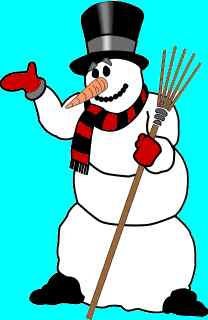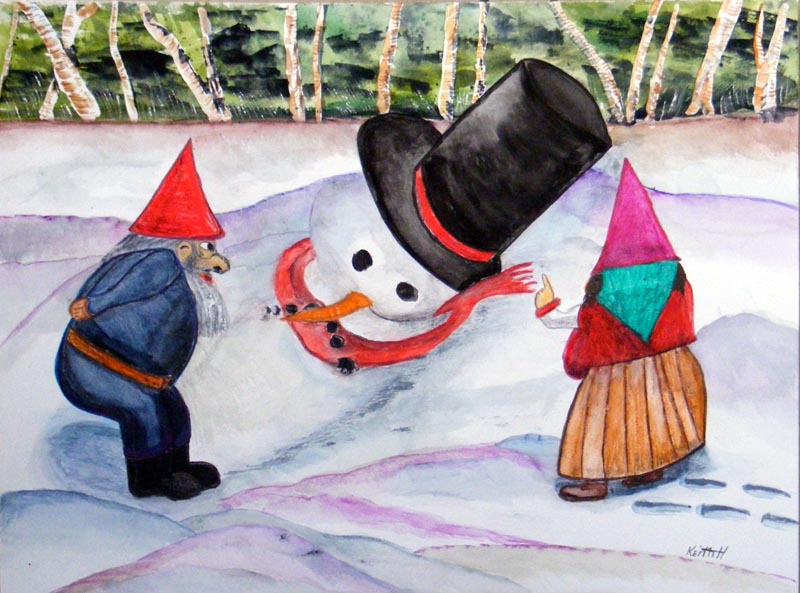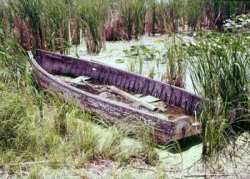 |
 |
| Home | Welcome | What's New | Site Map | Glossary | Weather Doctor Amazon Store | Book Store | Accolades | Email Us |
 | |||||||||||||
Weather Almanac for January 2001SNOW PEOPLE: AN ENDANGERED SPECIES?The early onset of full winter weather across most of North America during November and December 2000 has brought widespread sightings of those seasonal nomads of American and Canadian lawns -- the snow people. I have seen them on the news over the past eight weeks, caught by the camera while trying to look inconspicuous and blend into the backgrounds around the houses they know they can never enter.
The amorphous appearance of snowpeople has lead us to believe they are all snowmen, as we shall call them herein. Indeed even the French have been confused, calling them bonhomme de neige, the good man of snow. No one really knows when the snowmen first appeared, but there are many indications they usually made first contact with human children. Perhaps we humans have played a major role in their evolution, for their earliest figures likely formed naturally around rocks and tree stumps and, later, fence posts. The evolution of their bodies and facial features was likely assisted by playful humans who added features to the indefinite faces and patted down their forms to bring more shape to their torsos. Are snowmen our attempt to domesticate snow? There are records in the literature of their appearances in the 18th century, and in the 1830s book The Boy's Book of Sport and Games, there is an engraving of one. I understand that this snowman looked more like the puppet Punch of Punch and Judy fame than to today's common Frosty image. From the details in this book, it appears they were often mistreated by young boys who used them as targets for snowball throwing.
Because of their amorphous nature, snowmen appear to take on the characteristics and shapes of characters found in children's literature, changing through the years as styles and popular culture changed. Perhaps they are just described in those term as a matter of convenience when the non- believer is told of their appearance in town. We know they began to move into the cities of the US in the late 19th century. One of the first to be caught on film appears in an 1888 stereograph of playing children at Niagara Falls, New York by George Baker. The snowman is seen in the picture with arm out to hitchhike to parts unknown. In 1890, John Champlin and Arthur Bostwick in The Young Folks' Cyclopedia of Games and Sports noted the snowmen seen in the Northeastern United States looked like: "a man fitted with an old hat, with cinders for eyes and a clay pipe in its mouth." These snowmen, they reported, were "used as targets for snowballs."
John Sloan's 1914 oil painting Backyards, Greenwich Village depicts children surrounding a featureless snowperson with misshapen upper limbs and no neck; a young boy teasing it with a shovel. Michael Gold in 1930 described one observed skulking around a vacant lot on the Lower Eastside of Manhattan: "His eyes were two coals; his nose a potato. He wore a derby hat and smoked a corncob pipe. His arms were flung wide; in one of them he held a broom, in the other a newspaper. This Golem with his amazed eyes and idiotic grin amused us all for an afternoon." Daniel Carter Beard, one of the co-founders of the Boy Scouts of America, in Snow-House and Statuary, wrote instructions for children to construct a snowman and other figures, perhaps for the purpose of attracting others to the site. Few observations of snowwomen have been reported prior to the 20th century, but that is not surprising if snowmen too are recent colonists of the North American continent. Early European explorers came sans females of their people, and in some areas centuries passed before the first European women were seen by the natives. Early 20th century sightings describe snowmen, and now an increasing number of snow-women, as having the following features, most of which dealt with the facial details.
Also frequently reported as an accessory are pipes of various styles, though corncob pipes appear the prime fashion. This is an interesting commentary on the culture of the race. Would not smoking a pipe be a major health hazard for a people made of ice and snow? Around the turn of the 19th century, snowmen appear to have evolved a social status as well. The status of the individual was usually indicated by their style of headgear: a tall stove-pipe hat or derby generally signified wealth and high social position. The type of pipe smoked also indicated status level. As the 20th century progressed, significant changes began to appear in snowmen. More snowwomen began to appear. When some snowwomen became definitely seductive in their appearance, snow-men, reported Woody Allen in Radio Days, began displaying carrot genitalia. Newspapers, and later radio and television news, reported on the uproar in certain neighbourhoods when overly seductive and suggestive appearances and behaviours appeared among the lawn squatters. 
Then we have the case of one: Frosty The Snowman. In 1950, song writers Steve Nelson and Jack Rollins penned a folk ballad about this individual in the manner of Woody Guthrie's songs about Pretty Boy Floyd and Tom Joad. Gene Autry, the singing cowboy of film and television, then made the song a massive hit (and a fortune for Autry). It now is a standard song of the winter season. Frosty, according to the song, was a bit of a rogue, a James Dean-type character, rebellious against authority. He is said to have led a gang of children "running here and there all around the square" and "down the streets of town," yelling "Catch me if you can!"! But when the group was confronted by a traffic cop who ordered them to "Stop!," Frosty defied the authority, only pausing for "a moment" before "hurrying on his way" off over the hills and calling back to his youthful gang in farewell: "Don't you cry. I'll be back again someday!" Perhaps such behaviour stems from snowmen feeling slighted by human adults, for they rarely -- save the occasional snow-child -- receive invitations into human households. Outcasts in their tattered and worn hand-me-downs, they could only watch their human playmates return each evening to the warmth of hearth and cozy warm beds. Who then are these snowmen...and snow women? Some say they are Everyman, like us doomed to a transient life before melting away into a "landscape without love," according to Canadian poet P.K. Page who wrote of them in her poem The Snowman. She observed snowmen are tragic figures who "greyed a little too, grown sinister / and disreputable in their sooty fur" quickly aging under the environmental stresses of city life. Bernard Mergen, in Snow in America, wrote that their nature"Confirms that snowmen share the characteristics of their medium -- paradoxically hard and soft, substantial yet ephemeral, jolly but with a hint of what [Bill] Watterson's Calvin [of the Calvin and Hobbes comic strip] sees as 'Deranged Mutant Killer Monster Snow Goons.' " As we slide into the 21st Century, snowmen have taken advantage of the times and technical advances. Fast transportation has allowed some Canadian snowmen brief excursions to the tropical climes of Puerto Rico for the final days of their lives. Many have been seen recently in the southern United States as far south as Northern Florida. But we still do not truly know where they go at the end of the season. Some say they "melt away" but I think that is just their outer shell. Their inner spirits likely steal off in early Spring when our attention turns away from snow and ice and toward robins and spring flowers. Some say they head north, but there does not seem to be a strong record of them in Inuit and Eskimo communities prior to European incursion. There does seem to be more sightings these days in the far north, perhaps a consequence and sign of global warming and increased snowfall at high latitudes. And what of that rogue Frosty and his peers? If recent images of them popping up in the media -- in magazines and newspapers, TV and the Internet -- as spokesmen for many products, services and causes, they seem to be doing well. Perhaps like Michael Jordan and Tiger Woods, they have found good agents and have signed lucrative endorsement deals for toys, books, videos, ornaments and candies, to name just a few. They have become symbols of the winter season as much as Jordan and Woods are symbols of their sport. Like many of their rebellious cohorts of the 1950s and 60s, they have mellowed, become well- rounded citizens, and now travel the globe spreading joy and goodwill, adorning seasonal greeting cards and festive displays for the holidays.  January Thaw or Global Warming? |
|||||||||||||
 |
To Purchase Notecard, |
Now Available! Order Today! | |
 |
 |
NEW! Now |
The BC Weather Book: |


